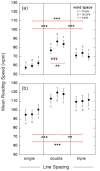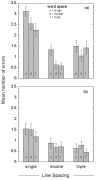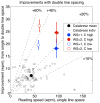Enhanced text spacing improves reading performance in individuals with macular disease
- PMID: 24244676
- PMCID: PMC3823704
- DOI: 10.1371/journal.pone.0080325
Enhanced text spacing improves reading performance in individuals with macular disease
Abstract
The search by many investigators for a solution to the reading problems encountered by individuals with no central vision has been long and, to date, not very fruitful. Most textual manipulations, including font size, have led to only modest gains in reading speed. Previous work on spatial integrative properties of peripheral retina suggests that 'visual crowding' may be a major factor contributing to inefficient reading. Crowding refers to the fact that juxtaposed targets viewed eccentrically may be difficult to identify. The purpose of this study was to assess the combined effects of line spacing and word spacing on the ability of individuals with age-related macular degeneration (ARMD) to read short passages of text that were printed with either high (87.5%) or low contrast (17.5%) letters. Low contrast text was used to avoid potential ceiling effects and to mimic a possible reduction in letter contrast with light scatter from media opacities. For both low and high contrast text, the fastest reading speeds we measured were for passages of text with double line and double word spacing. In comparison with standard single spacing, double word/line spacing increased reading speed by approximately 26% with high contrast text (p < 0.001), and by 46% with low contrast text (p < 0.001). In addition, double line/word spacing more than halved the number of reading errors obtained with single spaced text. We compare our results with previous reading studies on ARMD patients, and conclude that crowding is detrimental to reading and that its effects can be reduced with enhanced text spacing. Spacing is particularly important when the contrast of the text is reduced, as may occur with intraocular light scatter or poor viewing conditions. We recommend that macular disease patients should employ double line spacing and double-character word spacing to maximize their reading efficiency.
Conflict of interest statement
Figures







References
-
- Legge GE, Pelli DG, Rubin GS, Schleske MM (1985) Psychophysics of reading: I Normal vision. Vis Resour 25: 239-252. - PubMed
Publication types
MeSH terms
LinkOut - more resources
Full Text Sources
Other Literature Sources
Medical

